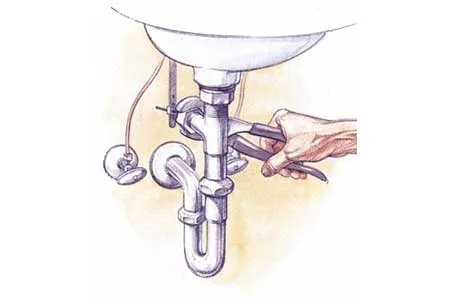A leaky drain plug wastes water and makes it impossible to keep your sink basin full. Homeowners can repair this issue in just a few minutes with pliers, an adjustable wrench, and one of several strategies. Read the guide below for tips on how to identify, fix, and maintain your sink’s drain plug so that you keep a watertight seal.
Understanding the Anatomy of a Sink Drain
Make sure you understand how the components of your sink drain system work before diving into repairs. This will help you to more successfully pinpoint the cause of the leak.
Components of a Sink Drain System
A typical sink drain system consists of several key parts:
- Clevis strap
- Drain flange
- Drain plug or stopper
- Lift rod
- P-trap
- Pivot rod
The drain plug is the visible part of the system that seals the drain opening. It connects to the pivot rod, which you can control with the lift rod you see on top of the sink. The P-trap, which is under the sink, prevents sewer gasses from entering your home by trapping water in a curved section of pipe.
Common Causes of Drain Plug Leaks
Several factors can contribute to a leaky drain plug, including those below.
- Damaged or corroded stopper
- Loose retaining nut
- Misaligned pivot rod
- Worn-out gasket
Tools and Materials Needed for Drain Plug Repair
Essential Tools
- Adjustable wrench
- Bucket or small container
- Flashlight
- Pliers
Optional Supplies
- Lubricating oil
- Plumber’s putty
- Replacement gasket
Step-by-Step Guide To Fix a Leaky Drain Plug
Follow the steps below to repair your leaky drain plug:
Inspecting the Drain Plug
Examine the drain plug and surrounding area by following these steps:
- Remove any visible debris from the drain opening.
- Check for signs of damage or wear on the plug.
- Make sure the plug sits flush against the drain when you close it.
Tightening the Retaining Nut
A loose retaining nut is frequently the cause of a leaky drain plug. Here’s how to address one:
- Look beneath the sink and locate the large retaining nut that secures the horizontal pivot rod to the back of the vertical drainpipe.
- Carefully tighten the nut with pliers.
- Test the plug by pulling up on the handle and turning on the water to see if it seals tightly against the drain.
If the plug still leaks, tighten the nut a bit more. Do not overtighten, though, as this can prevent the handle from raising properly.
Adjusting the Pivot Rod
If tightening the nut doesn’t solve the issue, adjust the pivot rod by following the steps below.
- Loosen the nut slightly.
- Adjust the position of the pivot rod so that it aligns with the drain plug.
- Retighten the nut and test the plug again.
Testing the Seal
After you’re done making adjustments, test the seal by following the steps below.
- Fill the sink with water.
- See if any water leaks through the closed plug.
- If leaking persists, move on to advanced troubleshooting techniques.
Advanced Troubleshooting Techniques for Drain Plug Repair
If the basic fixes don’t resolve the leak, consider one of the more advanced solutions below.
Replacing the Gasket
A worn gasket can cause persistent leaks. Address this by following the steps below.
- Remove the old gasket from the drain plug.
- Clean the area thoroughly.
- Install a new gasket that’s the same size and type as one you removed.
- Reassemble the drain components and test the system.
Using an ill-fitting gasket can lead to continued leaks or even new issues.
Reseating the Stopper
It’s possible the stopper may not be seated correctly. Follow the steps below to reseat it:
- Remove the stopper completely.
- Clean the stopper and the drain opening.
- Apply a small amount of plumber’s putty around the drain opening.
- Reseat the stopper and make sure it sits flush.
If the stopper isn’t correctly seated, it can’t form a watertight seal.
Preventive Maintenance for Drain Plugs
Maintain your drain plug properly to prevent future leaks and extend the life of your drain plug system.
Regular Cleaning Tips
Keep your drain plug functioning smoothly with these cleaning practices:
- Pour boiling water down the drain to clear blockages.
- Remove hair and debris regularly.
- Use a combination of baking soda and vinegar to clear the drain.
- Use a drain snake to attend to stubborn clogs.
- Use drain clearing liquid if other methods don’t work
When To Call a Professional Plumber for Drain Repair
You can fix many drain plug issues with DIY methods, but some situations warrant professional help. Call a plumber if any of the variables below apply.
- Leaks persist even after you’ve attempted repair.
- There’s visible damage to the drain pipe or sink basin.
- You don’t have time or tools to complete the repair.
- You have complex drain systems that are beyond your expertise.
A professional plumber can diagnose and fix complex issues efficiently and safely. Plumbers have the tools and expertise necessary to tackle problems that can be challenging for the average homeowner.

